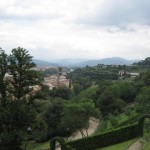ベゴニア/Begonia grandis by nobuflickr
This past weekend TheGardenLady visited a lovely garden in Bryn Mawr, Pennsylvania. The owner wanted to show me what she had in bloom. Under the trees in the shade and growing in the pachysandra were her hardy begonias – begonia grandis. She especially wanted to show off these plants that were now in flower because she had learned about Carolyn’s Shade garden from the TheGardenLady’s recommendation. This is where she bought these begonias as well as all her other healthy shade plants. And these hardy begonias were not only hardy because they overwintered but because when they are happy and they were so happy in her garden that they are popping up all over. And the flower display was so lovely – flowers with the bonus of a light fragrance.
TheGardenLady had always loved begonias and was familiar with annual begonias, Rex begonias and tuberous begonias but it was only a few years ago that I learned that there was a hardy begonia that would overwinter in zone 6. This was when a friend gave me a baby begonia grandis plant. This plant grew in my garden for a few years but this year’s drought killed it. I am so sad and plan on getting another next year.
Begonia grandis originated in East Asia – China and Japan and is the most cold hardy of all the begonias. It grows as a perennial in temperature zones 6 through 9. In zone 5 it is considered a tender perennial which means that it might survive with a good covering of mulch but you would be safest to take it indoors for the winter. Hardy begonias bloom in late summer and autumn and will propagate itself by seed and bulbils formed in the leaf axils. The plant grows about 2 feet tall and likes part to full shade – it does not really want afternoon sun. It tolerates morning sun and this allows you to see the red veins in the leaves. Begonia grandis seems to tolerate all soil types but likes woodland soil best and tolerates all pH levels though it prefers neutral to slightly acid soil with good drainage and average watering. It can be used as a ground covering.






















































